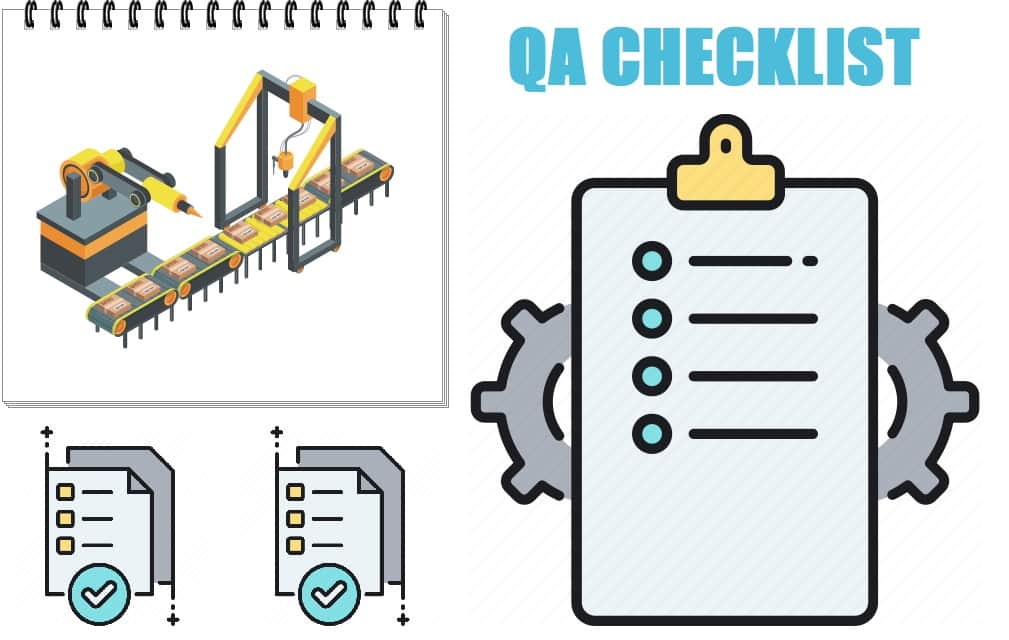QA checklist (inspection criteria sheet) is an important quality inspection & evaluation tool used to measure the value of a product. This structured questionnaire facilitates the collection and analysis of the information necessary to determine the strengths and weaknesses in the quality of the production work. Here, we go over what a quality control checklist is and how it is developed for quality inspection in the manufacturing industry.

What is QA Checklist (Quality Inspection Criteria Sheet)?
The QC checklist, also called quality checklist or inspection criteria sheet, is a generally printed format used to collect data by observing a specific manufacturing situation or production process. The collected data represents an input for the use of other quality control tools such as the Pareto or scatter diagram. Quality checklists are one of the most important quality inspection tools, which offer details related to product requirements, on-site testing, packaging, and other guides for inspectors during quality inspection. In this sense, a check sheet is a generic tool used for a multitude of purposes that go beyond quality.
Although we mention that you usually work with the checklists in a physical way (printed or drawn), the software on devices such as tablets or mobiles has made it possible to work digitally with this quality tool. This provides a series of benefits, such as saving what is checked on the device or cloud or automatic tabulation of the data as the list is filled out.
What Do Quality Control Checklists Be Used For?
What is the function of a quality inspection criteria sheet? The main uses of checklists are the following:
- Carrying out producing process in which it is important that no steps are forgotten and / or tasks must be done in an established order.
- Carrying out quality inspections where it must be recorded which points have been inspected.
- Check or examine articles.
- Examine or analyze the location of defects. Check the causes of the defects.
- Verification and analysis of operations.
- Collect data for future analysis.
Ultimately, these lists are often used to carry out routine checks and to ensure that the operator or the person in charge of said checks does not miss anything, in addition to simply obtaining data.
The advantage of the QA checklists is that, in addition to systematizing the production to be carried out, once they are filled in they serve as a record, which can be later reviewed to keep track of the product manufacturing that were carried out at any given time.
How To Use Quality Checklists?
It is important that the QA checklists are clearly established and include all aspects that may provide data of interest to the organization. That is why it must be correctly included in the checklist:
- What has to be controlled or checked.
- What is the criterion of conformity or non-conformity (what is correct and what is incorrect).
- How often it is inspected: frequency of control or check.
- Who performs the check and what are the applicable procedures.
Finally, it is advisable to have an observations section in order to be able to obtain prior information on possible reasons that have caused the disagreement.
On the other hand, if we are going to use checklists to obtain data, they can also be used to build graphs or diagrams to control the evolution of a characteristic or activity. They are also used to report the status of operations on a daily basis and to be able to assess the trend and / or dispersion of production, without the need for more complex statistics or graphs.
How To Create Quality Control Checklist Template?
There is no defined way to do a QA checklist. This will depend on the situation to be analyzed, for which everyone is responsible for designing their own sheet. However, there are some guidelines to take into account to achieve your own Inspection Criteria Sheet:
Step 1 – Content
We establish the context on which we are going to measure the data. Some possible aspects to verify in a process are these:
- Have the procedures been followed?
- Do the products meet the specifications?
- Are the dimensional measurements, weight, color, roughness … within tolerances?
- Has it complied with the resistance, waterproofing, torsion, etc tests?
- Have the records been filled in?
- Has there been an incident?
- Was the equipment in the correct state of maintenance? And were they calibrated/verified?
- Is the final product compliant?
Step 2 – Create Sheet Format
Look at what was defined in step 1. We require classifying data according to the week, the part of the computer and the number of services provided by each technician. We can adapt various types of check sheets through excel and other software.
Step 3 – Data Collection
Collect the data. It is important that the data is collected as defined in the how, when and where of step 1. This ensures the relevance of the data collected.
There is no excel template that can be used for any work with check sheets, as its design will depend on the situation to be observed. However, it is always useful to have references as a starting point to create your own checklist.